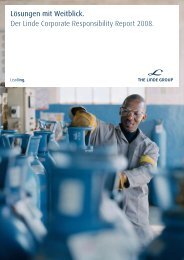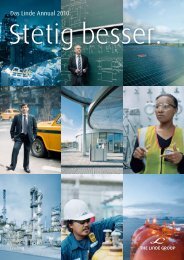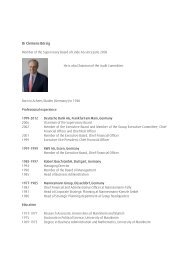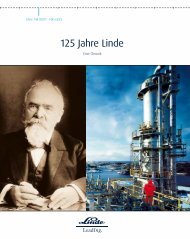The complete history of the development of The - The Linde Group
The complete history of the development of The - The Linde Group
The complete history of the development of The - The Linde Group
You also want an ePaper? Increase the reach of your titles
YUMPU automatically turns print PDFs into web optimized ePapers that Google loves.
78<br />
In 1980, at Meinhardt’s request, <strong>the</strong> <strong>the</strong>n CEO <strong>of</strong> Allianz,<br />
Wolfgang Schieren, joined <strong>Linde</strong>’s Supervisory Board and soon<br />
<strong>the</strong>reafter became its chairman, acting as a guarantor <strong>of</strong> stability<br />
and continuity.<br />
<strong>Linde</strong> in <strong>the</strong> United States<br />
1996<br />
<strong>Linde</strong> Gas LLC is mainly represented in <strong>the</strong> eastern United States and Puerto<br />
Rico. Approx 160 tanker trucks are on <strong>the</strong> highway.<br />
<strong>The</strong> total number <strong>of</strong> people infected with <strong>the</strong><br />
AIDS virus is estimated to be 22.6 million.<br />
N o 5124 Storage receptacle<br />
for cryogenic media (tank for liquid hydrogen).<br />
In 1990s, <strong>Linde</strong> stepped up its involvement in North America.<br />
Although <strong>the</strong> company had already been represented <strong>the</strong>re<br />
during <strong>the</strong> early years, it had not only lost its subsidiaries after<br />
<strong>the</strong> two world wars but even <strong>the</strong> rights to <strong>the</strong> <strong>Linde</strong> name in<br />
<strong>the</strong> US. <strong>The</strong> reference plants built after WWII did not immediately<br />
lead to <strong>the</strong> hoped-for breakthrough on <strong>the</strong> US market. In <strong>the</strong><br />
industrial truck market, however, <strong>the</strong> entry in to <strong>the</strong> US market<br />
through a subsidiary was finally successful with <strong>the</strong> takeover<br />
<strong>of</strong> <strong>the</strong> Baker Material Handling Corporation in 1977.<br />
<strong>Linde</strong> was successful in 1996 with <strong>the</strong> strategically important<br />
purchase <strong>of</strong> <strong>the</strong> Pro-Quip Corporation (TPQ) in Tulsa, Oklahoma,<br />
which is, among o<strong>the</strong>r things, <strong>the</strong> world market leader<br />
in small hydrogen plants. After this acquisition, Tulsa was built<br />
up to become a new “<strong>Linde</strong> center” in <strong>the</strong> US. In 1999, <strong>Linde</strong><br />
moved <strong>the</strong> subsidiary Lotepro Inc. from New York to Oklahoma<br />
and, at <strong>the</strong> end <strong>of</strong> 2001, merged Lotepro Inc. and <strong>the</strong> Pro-Quip<br />
Corp. into <strong>Linde</strong> Process Plants Inc. In 2002, <strong>the</strong> British gas company<br />
BOC acquired a 30 percent investment in this company,<br />
after which it was known as <strong>Linde</strong> BOC Process Plants LLC.<br />
In <strong>the</strong> US, <strong>Linde</strong> also expanded in <strong>the</strong> area <strong>of</strong> technical gases<br />
with <strong>the</strong> takeover <strong>of</strong> <strong>the</strong> Sunox Inc. gas company in Charlotte<br />
through subsidiary Holox Inc. And <strong>Linde</strong> successfully entered <strong>the</strong><br />
American hydrogen and carbon monoxide business through a<br />
cooperative agreement with Millenium Petrochemicals Inc.<br />
But symbolically <strong>the</strong> most important date for <strong>Linde</strong> in <strong>the</strong><br />
US was certainly January 1, 1999: As <strong>of</strong> this date, <strong>the</strong> North<br />
American group companies were once again permitted to use<br />
<strong>the</strong> name “<strong>Linde</strong>.” Forty-four years after <strong>the</strong> end <strong>of</strong> <strong>the</strong> war,<br />
<strong>Linde</strong> once again owns <strong>the</strong> rights to <strong>the</strong> “<strong>Linde</strong>” name and<br />
trademark in <strong>the</strong> United States.<br />
From Dr. Hans Meinhardt to Gerhard Full to<br />
Dr. Wolfgang Reitzle<br />
During <strong>the</strong> shareholders’ meeting in May 1997, Hans Meinhardt<br />
stepped down from his post as President and CEO <strong>of</strong> <strong>Linde</strong> AG<br />
after 21 years, taking instead <strong>the</strong> <strong>of</strong>fice <strong>of</strong> chairman <strong>of</strong> <strong>the</strong><br />
Supervisory Board, which he held until spring 2003.<br />
Under Meinhardt’s leadership, <strong>Linde</strong> received new structures<br />
and new fields <strong>of</strong> business and transformed itself from a<br />
technology-loving engineering company with strong ties to its<br />
founding family to a global, manager-led technology company.<br />
<strong>Linde</strong>’s sales during <strong>the</strong> “Meinhardt era” rose by a factor <strong>of</strong><br />
25. And pr<strong>of</strong>its after taxes grew by a factor <strong>of</strong> 33, from 7.2 million<br />
to 240 million euro. Over <strong>the</strong> same period, <strong>the</strong> number <strong>of</strong><br />
employees rose from 13,500 in 1970 to more than 46,500 in<br />
2002.<br />
In 1997, Gerhard Full became President and CEO. He had<br />
worked for <strong>the</strong> company since 1962 and was first in charge <strong>of</strong><br />
facilities engineering on <strong>the</strong> Executive Board (see also page 82).



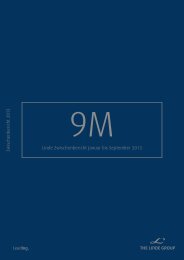
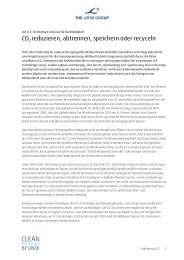

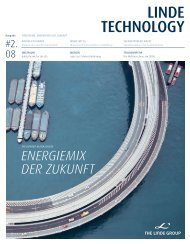

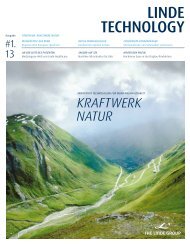
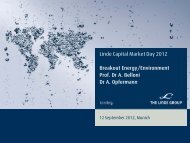
![[41] Anteilsbesitzliste des Linde Konzerns und ... - The Linde Group](https://img.yumpu.com/8356102/1/184x260/41-anteilsbesitzliste-des-linde-konzerns-und-the-linde-group.jpg?quality=85)
![[41] Anteilsbesitzliste des Linde Konzerns und ... - The Linde Group](https://img.yumpu.com/8356076/1/184x260/41-anteilsbesitzliste-des-linde-konzerns-und-the-linde-group.jpg?quality=85)
